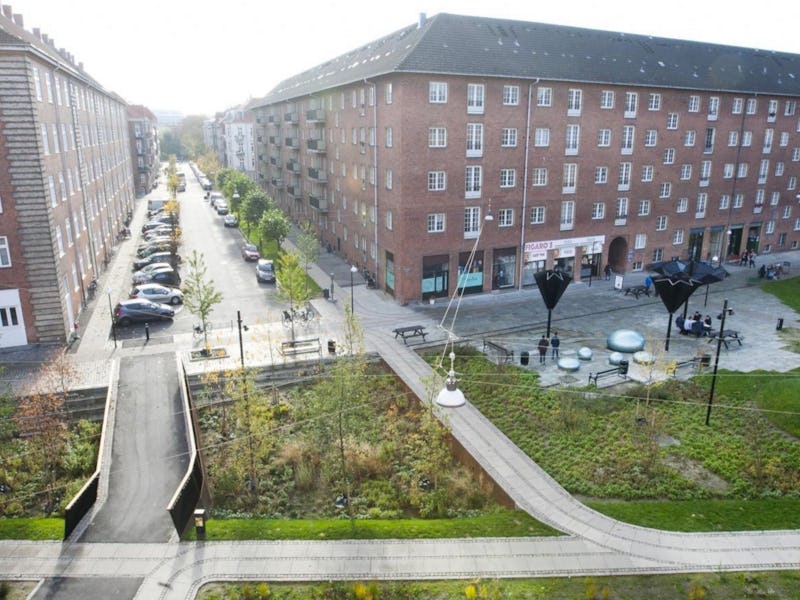This Futuristic Urban Park Harnesses Energy From Bouncing Children
The first climate change-adapted urban park in Copenhagen proves that parks in the future will be judged by utility in addition to beauty.

The beauty of a public park may draw people in, but the future demands a bit more from these public spaces: Copenhagen’s first climate-changed adapted park professes beauty and usefulness, a combination we’re likely to see more of in the future as the threat of climate change grows stronger.
Tåsinge Plads in Copenhagen is designed to handle the deluges of rainfall the city has experienced in recent years, removing pressure from the city’s overworked sewage system. In 2011 and 2014, the Danish capital was hit with two “100-year-floods,” causing million dollars in damage. Rather than resist the realities of climate change, urbanists in Copenhagen decided it was time to adapt.
“The climate is changing and in the future we can expect more precipitation and heavy rain falls. Therefore, the city of Copenhagen needs to be adapted to the changes,” Charlotte Brøndum, Project Manager at the Klimakvarter, said.
A sketch of the park's layout, in which you can see the three separate sections
The park is divided into three areas, each with a specific function that relates to relieving the burden of heavy rainfall: Solskrænten (Sun Slope), Regnskoven (The Rainforest), and Torvet (The Plaza).
A water tank beneath the Sun Slope collects rain water from surrounding buildings and cleans it for it to be reused later. The Sun Slope is also the highest point of the park, which means that water is directed downhill, ending up in the Rainforest section “where it will slowly infiltrate to ground water” if a spontaneous downpour occurs. The vegetation in the Rainforest section, which adds beautiful verdant aspect to the public space, forms natural tanks that collect rainwater and detect when water levels have gone down before draining.
The vegetation that doubles as water tanks
Curious and futuristic upside-down umbrella structures in the the Plaza serve as additional water collecting units for plant nourishment purposes. The Plaza’s bouncy floors that surround these upside down umbrellas are the main kicker for this state of the art park. When children jump up and down, the energy they create is harnessed to pump the water from the umbrella tanks through the pipes. I bet you never thought you’d see the day that a child’s inability to sit still serves the well-being of an entire city.
Tåsinge Plads boasts beautiful wild plant species in the middle of urban surroundings
Before Tåsinge Plads was built, it was a 7,000 square-foot plot of asphalt that neither served to improve the city’s beauty or combat climate change. Now it’s a gorgeous park where city dwellers can relax, and that relaxation is only bolstered by the fact that this park is lessening a burden on the city’s rainwater drainage system.
Following the success of Tåsinge Plads, city officials have approved an additional 300 similar projects that will be constructed within the next 20 years.
The park's landscape emphasizes beauty just as much as utility
Copenhagen’s initiative to address climate change through public parks sets an essential example for other cities around the world. Not only does this nature-first approach, referred to as blue and green infrastructure, do away with the costly and harmful effects of gray infrastructure (drilling, laying pipes, expanding underground systems), but it converts aesthetically unappealing and empty plots of asphalt into beautiful centerpieces for the city.
As the threat of climate change grows more menacing — and it surely will — other cities should look to Copenhagen as an example of how beauty and utility can and should go hand in hand.
Upside down umbrella structures with surrounding bouncy ground